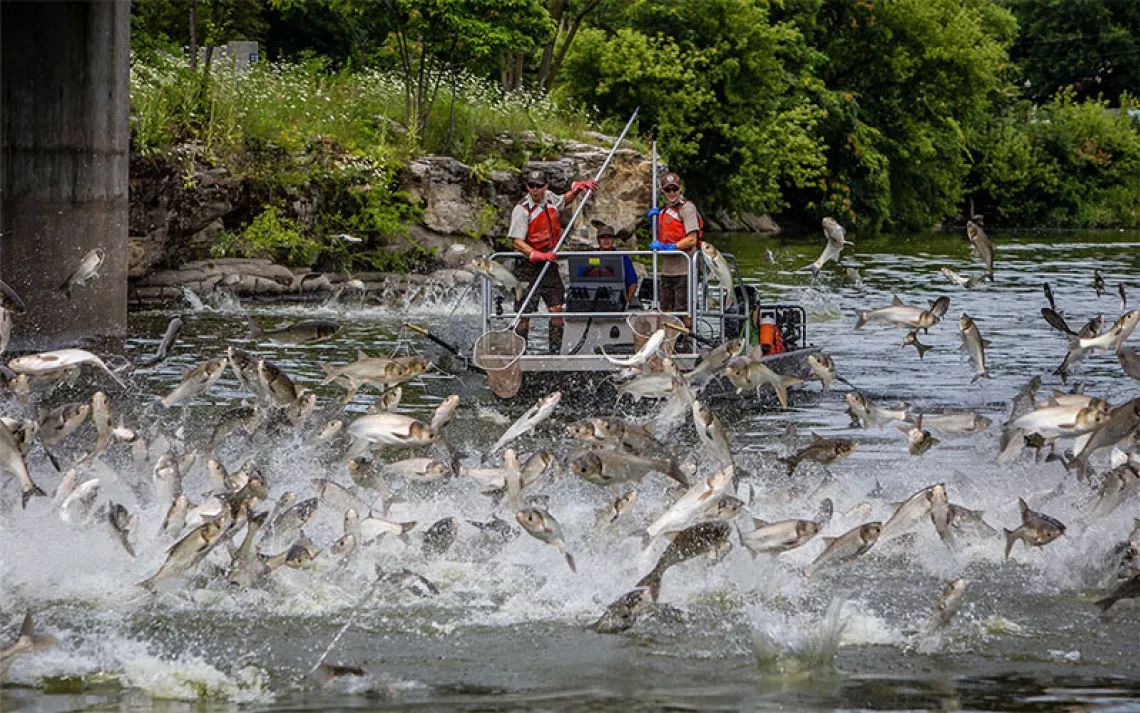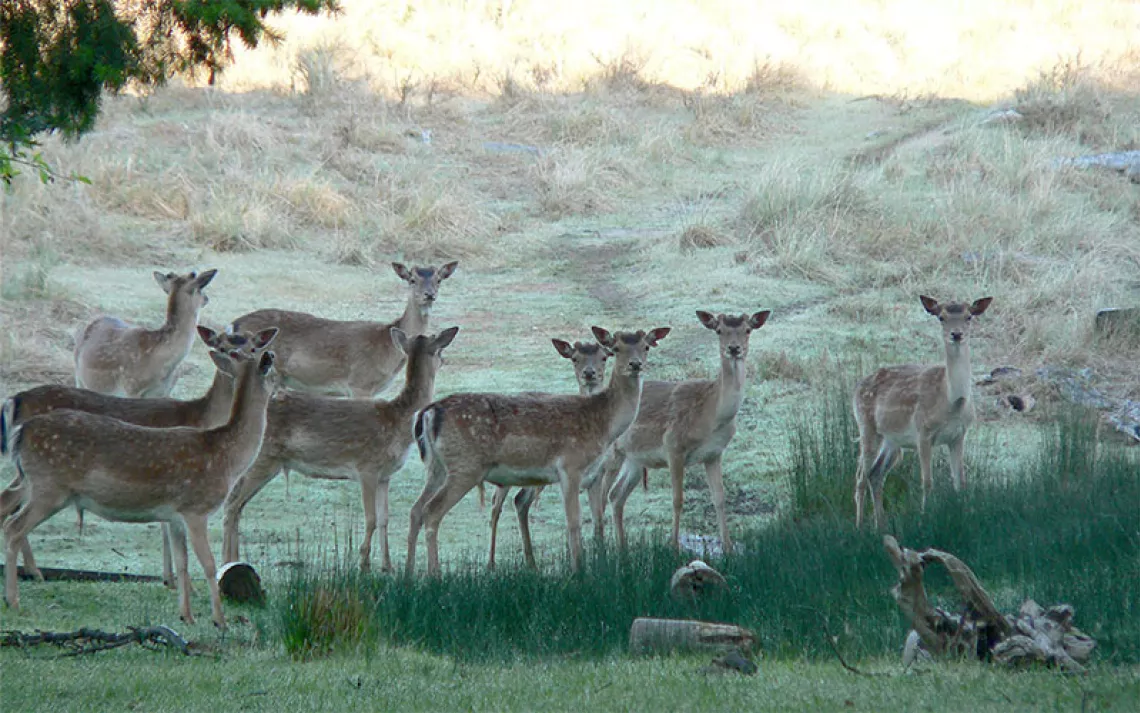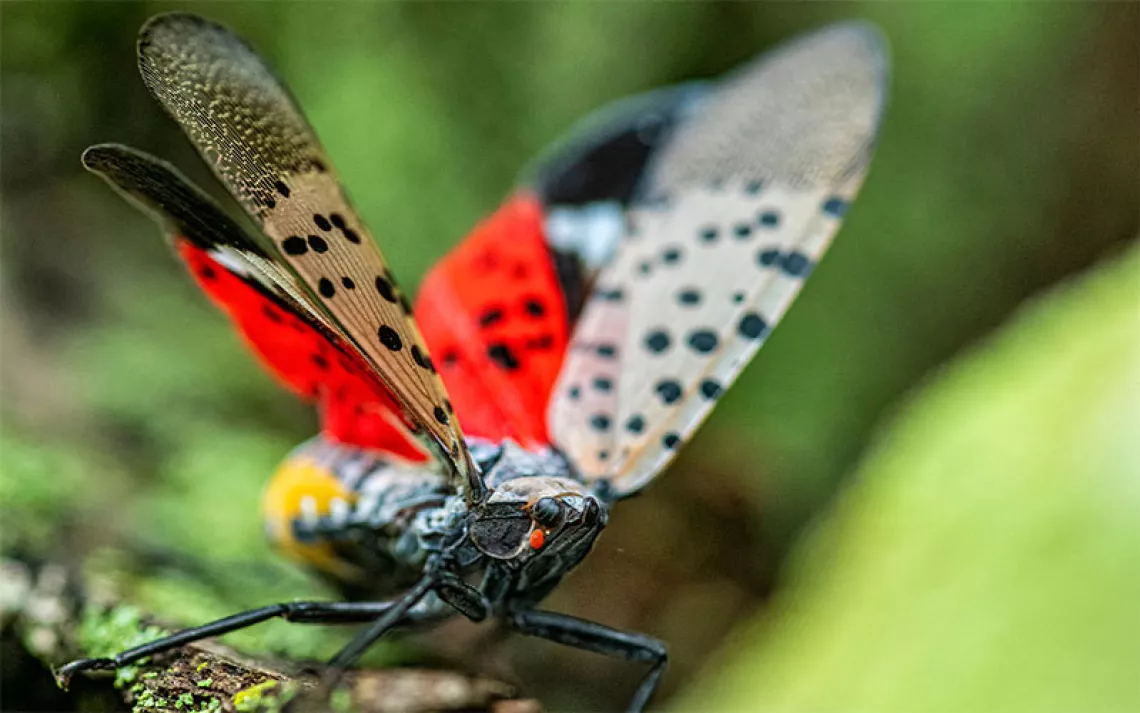Invasive Species Can Wreak Havoc. Case in Point: the Everglades.
Here's what experts say can be done about it

Photo by JC Shamrock/Getty Images
This story first published in Knowable Magazine.
Throughout the ’70s,’80s, and ’90s, Frank Mazzotti would see many rabbits as he drove down to his study site in Florida’s Everglades National Park. Every hundred meters or so, one of them would be sitting by the roadside—usually a marsh rabbit, sometimes a cottontail.
But starting in the early 2000s, they began to disappear. Water flow in the park had altered drastically, says Mazzotti, which could have made it harder for the creatures to survive. But scientists would soon discover a major culprit behind the declines.
A new predator had recently established itself in the park: Burmese pythons, descended from escaped or released exotic pets that appeared to thrive in the rodent-rife interior of the Everglades. When Mazzotti, an ecologist at the University of Florida, and others began tallying the mammals spotted along roadsides, they found that by 2011, sightings of raccoons, opossums and bobcats had plummeted by up to 99 percent, with losses heaviest in python-invaded areas. The rabbits were entirely gone.
Other scientists released rabbits with tracking devices into the park and found that most of them ended up inside the often-lumpy bodies of satiated snakes. Clearly, the Everglades had a python problem.
Pythons aren’t the only species in the Everglades that doesn’t belong there. In fact, South Florida tops the charts among non-island regions for the number of now-resident non-native species—with sightings so common that many locals consider them part of the natural habitat. Non-native plants make up a third of Florida’s total plant biomass; introduced birds account for a third of bird sightings in Miami-Dade County. A staggering 92 percent of reptiles and amphibians in Miami parks are non-native as well. Florida is effectively a zoo of alien species.
Only now are scientists learning just how far-reaching the impacts of these guests are in ecosystems like the Everglades—from transforming food webs and spreading disease to worsening wildfires and possibly even affecting human health. Florida’s invasive species are threatening a landmark endeavor to restore the Everglades ecosystem: Tens of billions of dollars are going toward its recovery after decades of taming, draining and degradation. Officials are spending tens of millions in the state each year to kill off non-native species that are proving impossible to entirely eradicate.
Like few other places, Florida’s unintended runaway experiment demonstrates the true cost of allowing non-natives to take hold where they don’t belong. As species invasions mount, Florida scientists hope that their experience will serve as a call to other regions to set up more safeguards against non-natives. “I hope people can learn from us,” says conservation ecologist Christopher Searcy of the University of Miami. “Because it seems really hard once it’s gotten this far to do anything about it.”
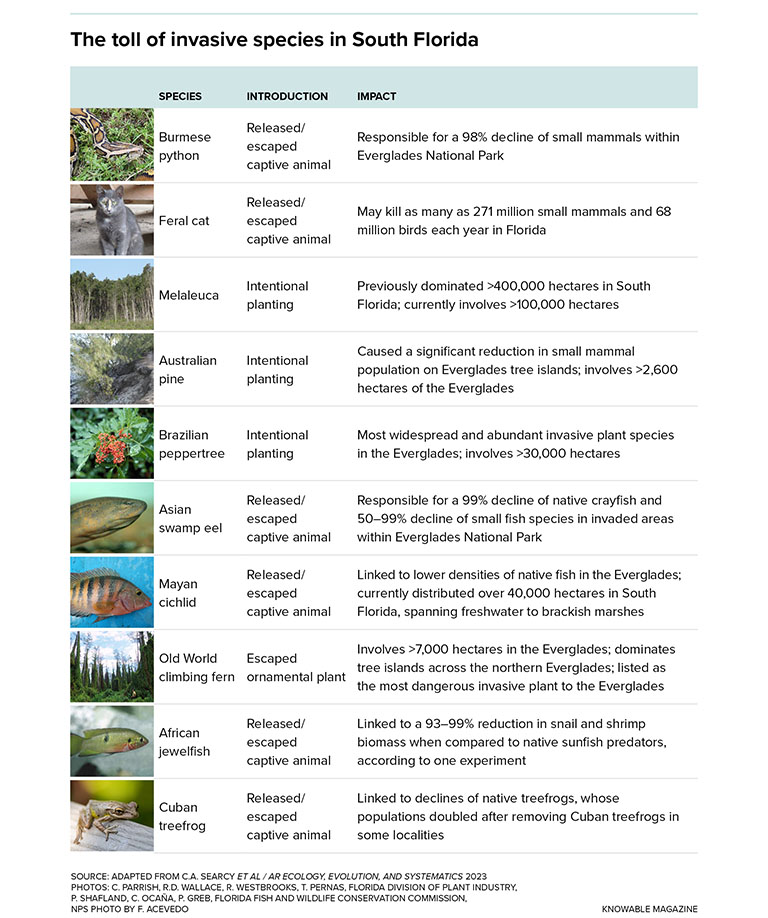
A perfect storm
There are many reasons why Florida is an invasion hotspot. It’s a major hub for the trade of exotic pets and ornamental plants, which slip into the wild accidentally or intentionally—surprisingly often, owners release pets that have grown too big or too hard to manage.
Many of these exotic species thrive in sunny Florida. They’re helped, scientists think, by Florida’s unique geography: Surrounded by oceans and frostier climes, the state sports less diverse and less competitive ecological communities than do other tropical regions, making it easier for foreign species to establish. For instance, there is no other constrictor snake in the Everglades for the Burmese python to compete with—and the ecosystem lacks any predators to keep it in check.
On top of this, huge swaths of Florida’s natural habitats, including roughly half of the original wetlands, have been converted into farmland or urban areas, and this is where most of Florida’s non-native species live. “A lot of the invasives are species that naturally do well with humans,” says Searcy, who recently coauthored a paper on Florida’s invasive species problem in the Annual Review of Ecology, Evolution, and Systematics. Disturbing the habitat also creates environmental conditions that these new species do better in, Searcy adds, whereas native species are stripped of those that they were adapted to.
Some of these foreign species have made their way into the remaining parts of the Everglades, where past human disturbance continues to fuel their spread. Non-native plants have thrived in formerly plowed and fertilized soils in some areas, while terrestrial vertebrates like brown anoles and greenhouse frogs are thought to have benefited from the historical drainage of swampland. Argentine black-and-white tegus and pythons have used as highways the canals and levees that were built to drain the region.
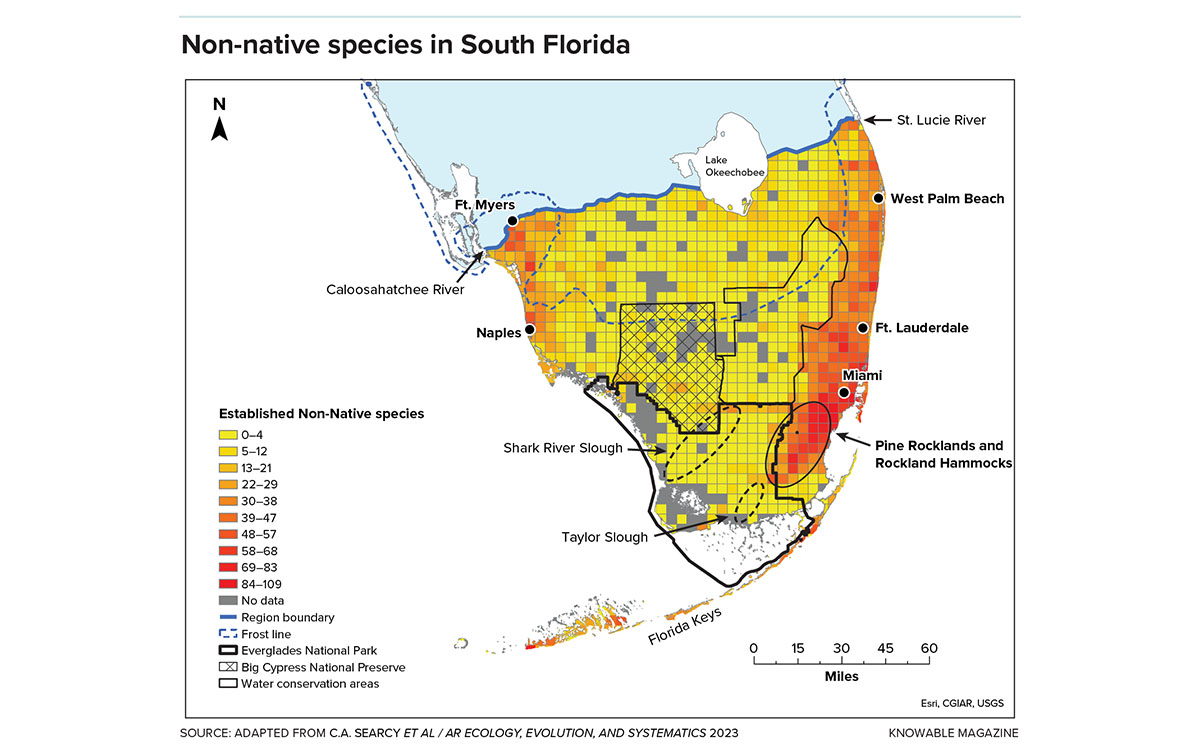
Ironically, the multibillion-dollar effort to restore the Everglades through reestablishing the natural flow of water has brought its own problems. Plugging drainage canals created deep ponds where non-native fish can survive winter freezes and breed profusely. Diversion of water to replenish the marshes spread these species across the ecosystem, says biologist Jon Lane, chief of the Invasive Species Management Branch in the Jacksonville District of the US Army Corps of Engineers, which is involved in the restoration effort.
“When we initially put these projects into play,” he says, “we didn’t even think about what was in the water that we were moving.” He recalls that a pool near the park entrance once abounded with bass, bluegill, gar and bowfin—it’s now filled with foreign species like oscars, Mayan cichlids, tilapia and suckermouth catfish.
Not all alien species become invasive, meaning that they are harmful to ecosystems, the economy or people. Some are arguably beneficial, like South American apple snails that are a food source for the Everglades’ snail kite, an endangered bird. And many foreign species in South Florida—like the brown anole, greenhouse frog and Brahminy blind snake—seem to be relatively benign, although no one has investigated their impacts, Searcy notes.
But a small minority of these species can wreak ecological havoc—and the pythons are the tip of the iceberg.
Upsetting the apple cart
Searcy hears only occasional frog croaks in the southeastern Everglades these days: “It’s very different from the northern Everglades,” he says, “where you hear hundreds of frogs calling.” Searcy suspects that the culprit behind precipitous amphibian declines that he and colleagues have documented could be the Asian swamp eel, a delicacy in Asian cuisine that eats just about anything and appears to be spreading with the hydrological restoration efforts.
Researchers have flagged other concerning declines. Last year, aquatic ecologist Matthew Pintar of Florida International University and his colleagues reported a massive collapse of crayfish and small fish populations in a major watershed in the southeastern Everglades, just a few years after the swamp eels showed up there in 2012. Crayfish numbers plummeted by more than 99 percent. “It was extremely dramatic. I was very surprised that no one had even noticed this before,” says Pintar, who is also a researcher at the environmental services company BIO-WEST.
What particularly concerns scientists about these drops is how they could disturb the rest of the ecosystem, since crayfish and small fish are key food for wading birds like egrets, herons, ibises, spoonbills and storks, which congregate in the Everglades to breed. Mammal declines due to pythons may have knock-on effects as well: Fewer racoons for instance, means fewer mammals to eat reptile eggs, which could cause a surge in native and non-native reptile populations. “It could be one of the reasons why iguanas and also tegus are doing so well,” Mazzotti speculates.
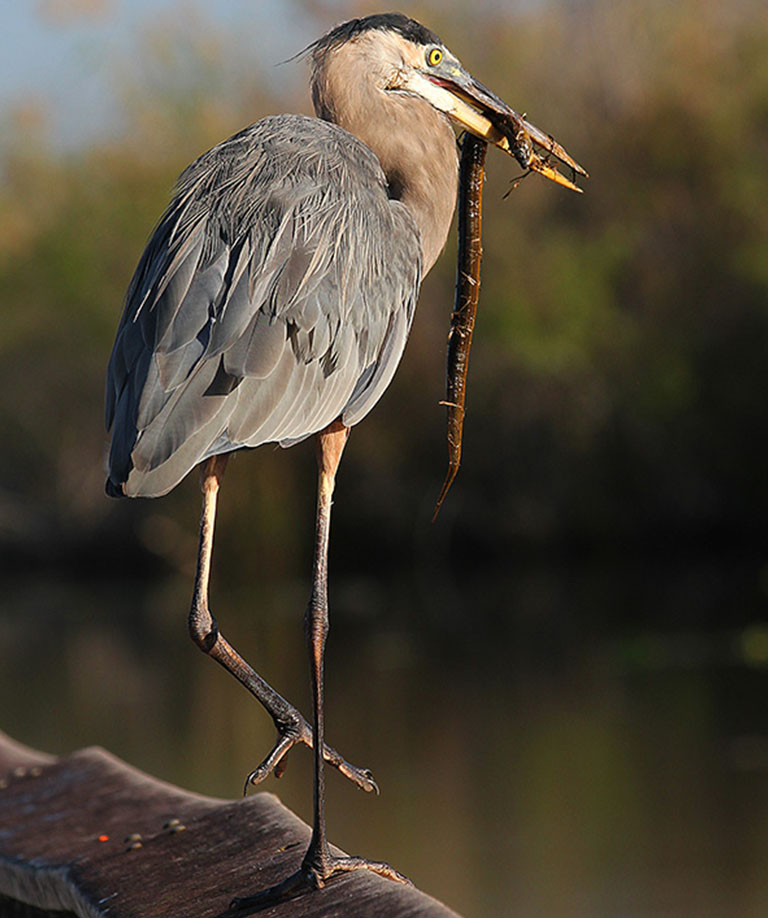
Native birds have sometimes been spotted eating Asian swamp eels — a destructive invader in parts of the Everglades — but it’s unclear whether this will help to stem the eels’ spread. | Photo by Judy Gallagher/Flickr
Such cascading impacts can sometimes have bizarre outcomes. Researchers recently learned that the pythons are disrupting local disease dynamics—namely, transmission of the Everglades virus, a mosquito-borne pathogen that can cause dangerous brain inflammation in people. Before the pythons’ arrival, mosquitoes fed on a diverse range of mammalian hosts, some of which aren’t very good at passing the virus to other mosquitoes. But now that the pythons have gobbled up many of those mammals, the mosquitoes are focusing on cotton rats, which happen to be very good at transmitting the virus. “If more mosquitoes are going to be carrying this virus, certain areas could see increased prevalence of Everglades virus in humans,” says invasion ecologist Melissa Miller of the University of Florida.
Pythons and other invaders have also brought brand new animal diseases to the region. Miller has found lungs of native snakes riddled with a species of pentastome—worm-like parasites—that Burmese pythons carried from Southeast Asia. Alarmingly, the parasites have spread as far as Northern Florida, well beyond python-infested areas, passed from snake to snake when infected individuals cough up pentastome eggs, contaminating the soil and water. The eggs are then eaten by beetles, which are consumed by small animals that other snakes prey on.
The pentastomes are larger and more numerous in native snakes than they are in pythons, and Miller is investigating whether this means they’re more debilitating, and if they are contributing to declines in native snake populations.
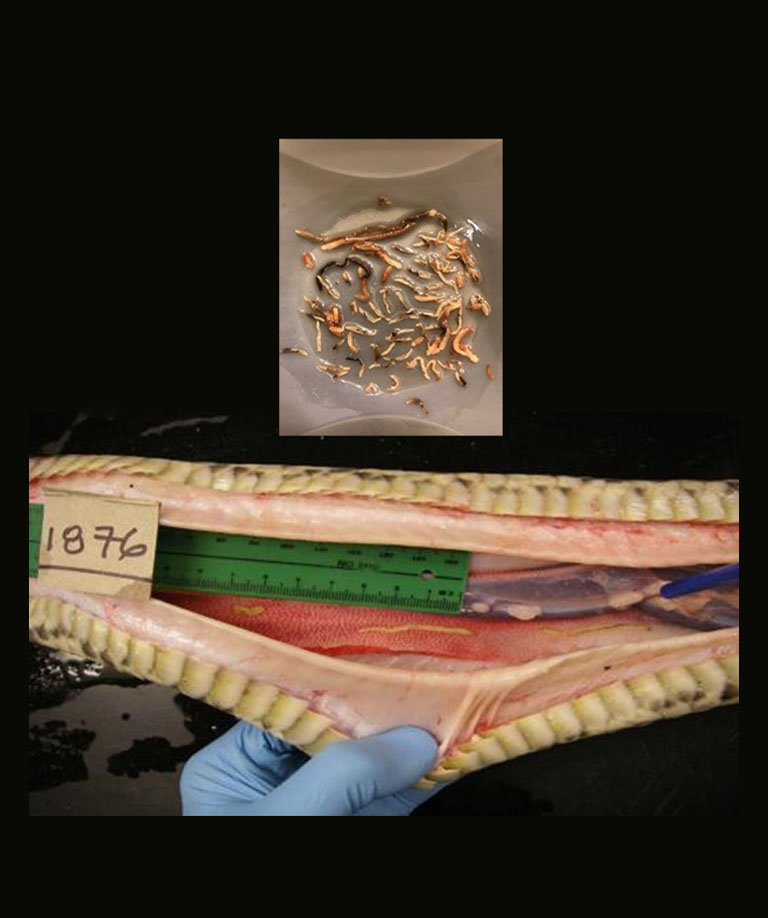
Burmese pythons have introduced a new lung parasite — a pentastome species called Raillietiella orientalis — to Florida, where it’s infecting native snakes in large numbers. | Photo by Skip Snow; Inset by Melissa Miller
Unwelcome plants
Some of the most destructive invaders are plants, which can reconfigure ecosystems by smothering and outcompeting native species. Melaleuca, a thirsty tree from Australia that was deliberately introduced to stabilize levees and was promoted as a way to help drain the region—seeds were once dropped by airplanes—has invaded the Everglades’ vast prairies of sawgrass and muhly grass. Thickets of melaleuca harbor few native crayfish, fishes or birds. The species’ industrious seed production, rapid growth and ability to change soil nutrients, alter worm diversity and produce a leaf litter rich in growth-inhibiting chemicals has likely helped it to repress other plants. “You would not have an Everglades in 50 years if you just let melaleuca go,” Lane says.
Other invaders include Australian pine, introduced as a windbreak; Brazilian peppertree, brought in as an ornamental species; and Old World climbing fern, escaped from cultivation back in the 1960s. University of Florida ecologist S. Luke Flory helicoptered over the region a couple of years back and saw extensive growth in parts of the Everglades: “As far as you can see, it’s covered by this climbing fern,” he says.
These invaders have not just quashed biodiversity, they’ve also altered the fire cycle in parts of the Everglades. The prairies and pine forests are prone to fires, when lightning sparks slow-burning, ground-level fires that burn off weedy species and tamp down grass that may otherwise hinder the flow of water. But the Brazilian peppertree has been observed to suppress controlled burns, and Old World climbing ferns can form ladders for flames to climb into the canopies of cypress trees, which didn’t used to burn and whose crowns aren’t adapted to fire, Lane says. This can kill the trees, leading to collapses of cypress domes, tree-studded mini-swamps that pepper the Everglades.
Melaleuca leaves, meanwhile, are full of oily compounds that fuel fierce, hot fires that reach the canopy and send embers flying in the wind. Fire also triggers the tree’s pods to open, releasing millions of seeds; one study counted nearly 600 melaleuca seedlings per square meter in the aftermath of a wildfire in 1998.
Some ecologists think that this cycle of invasion and fire, over several decades, is how melaleuca colonized a million acres in Florida. Though much of it in the Everglades is now being contained, park managers still monitor remaining melaleuca patches closely after fires, says botanist Hillary Cooley, who leads Everglades National Park’s invasive vegetation management program.
Invasive plants don’t need to be especially flammable to cause such cycles. Cogongrass, introduced as forage and for erosion control, is a widespread problem in Central Florida. It can unleash raging infernos by creating large, contiguous areas through which fire is thought to spread more rapidly than among native plants, which tend to form patches in the landscape, explains Flory. “The invader then survives or does better in the face of the intense fires they created,” Flory adds. One of his studies documented a proliferation of cogongrass regrowth in the aftermath of hot, cogon-fueled fires, while few seedlings of native species emerged.
Ecological meltdown
Scientists also worry that individual invasive species interact in ways that make them more destructive. For a century, an ornamental fig species was an innocuous inhabitant in Floridian gardens until the arrival of its wasp pollinator, which turned the tree into a prolific pest. Similarly, green iguanas spread the seeds of non-native plants, and red-whiskered bulbuls consume the fruit of non-native trees, helping to disproportionately disperse them.

Sign up to receive Sierra News & Views
Get articles like this one sent directly to your inbox weekly.
With this action you affirm you want to receive Sierra Club communications and may vote on policy designated by the Sierra Club Board.
Researchers don’t know why non-native species appear to be more likely than native ones to facilitate the spread of invasives, but such invasional meltdown, as it’s termed, is a growing concern for Florida, says ecologist Betsy von Halleof George Washington University. “The real implication for policy,” she says, “is that much more should be done to prohibit species coming in.”
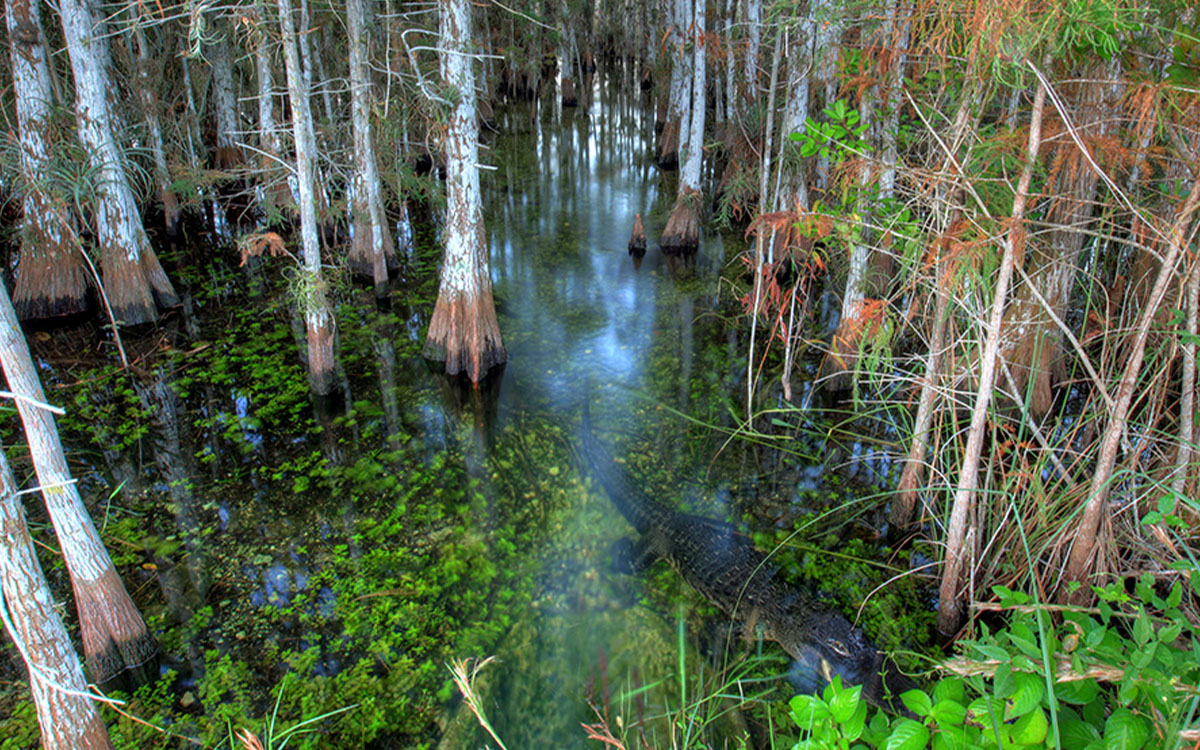
Cypress domes — clusters of cypress trees that grow in swampy depressions — are important habitats for alligators and other species in the Everglades. The introduction of exotic plant species poses a risk to them. | Photo by Glenn Gardner/NPS via Flickr
Another future worry is what climate change will do. In general, the warming of habitats is expected to fuel the spread of existing non-native species into climes that are currently too cool for them. Climate change will also cause rising sea levels and heavier, more sporadic rains that could trigger more frequent flooding. “That’s going to move species around,” says invasion ecologist Deah Lieurance of Penn State University. Flory just finished a study to track whether hurricane-associated flooding could more extensively spread invaders in the Everglades. Some of his research also suggests that more intense droughts could make the native longleaf pine tree more vulnerable to cogongrass-fueled fires.
Florida’s ever-worsening invasion problem projects a rather bleak outlook for the Everglades, in spite of one of the world’s costliest ecological restoration efforts. According to a 35-year-plus plan originally enacted in 2000 by Congress, the South Florida Water Management District, the US Army Corps of Engineers and other agencies have been working to divert the fresh water that is being drained into the ocean back through Everglades National Park to recreate its natural flow of water. This is being done by plugging drainage canals, pumping water around and removing roads to allow water flow.
Lane notes that almost every single invasive species has spread further since the restoration effort began. This raises serious questions, he says: If invasives aren’t dealt with—resulting in a Frankensteinian ecosystem teeming with pythons, Brazilian peppertree and Asian swamp eels—then what is the point of restoring natural water flow?
Some researchers, meanwhile, argue that invaded habitats in general can be ecosystems in their own right and question the notion of eradicating alien species just for the sake of preserving them in an original, native state—which may be an unattainable ecological ideal anyway. “It treats ecosystems as stable and sacrosanct entities in a way that they just aren’t,” says Bob Fischer, an ethicist at Texas State University. After all, he adds, many ecosystems, including the Everglades, are already greatly modified by people. “It really neglects the role that humans are playing in changing the ecosystem and scapegoats the particular animals.”
Stalemate with invaders
Yet Lane and others point to the mounting damage caused by invasive species—they are recognized as major causes of biodiversity loss, on par with climate change and pollution. According to a recent international biodiversity panel report, invasives have played a role in 60 percent of known plant and animal extinctions and are responsible for more than $423 billion in annual global damage, with particular harm to food crops and fisheries. In Florida, recreational fishing could suffer if the hungry South Asian bullseye snakehead fish reaches Lake Okeechobee, one of the best bass fishing lakes in the United States. And Florida cattlemen are already concerned about the spread of the pasture-smothering tropical soda apple.
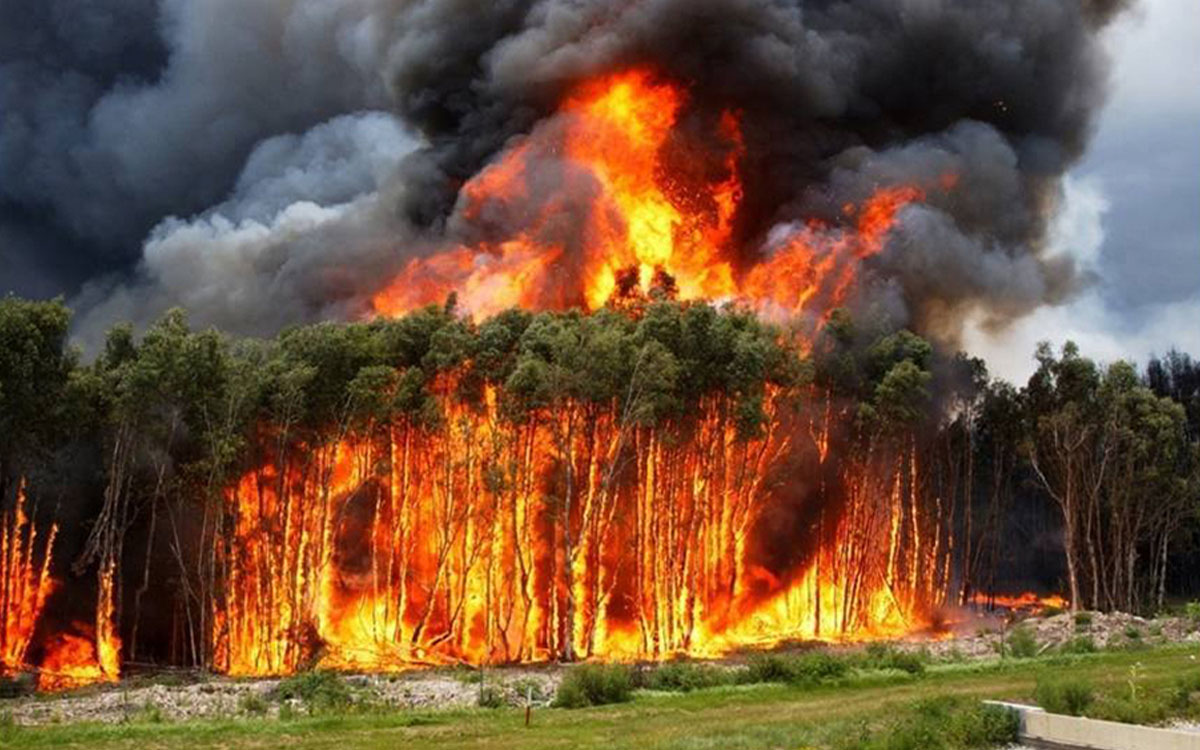
Melaleuca contains oily compounds in its leaves that ignite much fiercer fires than the Everglades ecosystem is accustomed to. | Photo courtesy FWC
In the Everglades, policymakers are increasingly putting money into containing some of the invaders. Since around 1990, a joint effort by several state and federal agencies has significantly knocked back melaleuca and Australian pine populations with an onslaught of herbicide treatments and the release of insects that are known to parasitize melaleuca in its native range, reducing its growth and reproduction. Within one area of the eastern Everglades National Park that once sported 5,000 acres of melaleuca, all but 67 acres of melaleuca have undergone at least one round of treatment. “You can see the results,” Cooley says.
And complete eradication of many species, especially well-disguised pythons, will be impossible in the vast, impenetrable wetlands. The best that scientists can hope for is to contain python populations enough to protect creatures like the endangered Key Largo woodrat and the cotton mouse. “I don’t think that we would ever get the Everglades back to its pristine state,” Lieurance says. “But let’s try to get it as close as possible.”
The cost of these efforts is already immense; Florida state and federal agencies spend some $45 million a year on managing invasive plants alone. Culling animals that are capable of experiencing pain and suffering also raises ethical questions, especially in cases where there’s not evidence that they cause ecological damage, says Fischer. In 2019, he coauthored a paper questioning the widely encouraged killing of green iguanas from Central and South America in Florida’s urban habitats, where they are more of a nuisance than a danger, defecating on porches and gobbling up ornamental plants.
But often, scientists worry that by the time non-native species are proved to have significant impacts on local wildlife, it will be too late to eradicate them. Consider the Argentine black-and-white tegu, which has been spotted eating the eggs of native reptile species and might end up causing declines in sea turtles and the threatened American crocodile. “Let’s not wait till we find out,” Mazzotti says.
Indeed, these laborious, expensive and ethically fraught challenges are the cost of waiting for new arrivals to become problems. That isn’t unique to Florida; globally, nations spend over 25 times more on managing invasive species than on preventing their introduction, and invasions continue to mount as global trade intensifies. It may, of course, never be possible to entirely stop alien species from entering—even seeds in tourists’ suitcases can bring in foreign plants—but some countries have found ways to curb the influx, says ecologist Vigdis Vandvik of the University of Bergen in Norway.
Vandvik points to Australia and New Zealand, which boast some of the world’s strongest biosecurity policies to prevent biological invasions, including strict regulations on which animals and plants people can import, inspections of travelers at airports, screening of international mail, fumigating shipments from high-risk countries to kill off pest beetles, and—for species already on land—meticulous monitoring in natural areas to nip infestations in the bud.
Florida is working to ramp up its biosecurity measures. Lieurance recently coauthored a study that identified 40 species from around the globe, such as zebra mussels and crab-eating macaques, that could easily become established and cause harm in the state, to aid in efforts to prevent their establishment in South Florida. Already, rapid-response teams have succeeded in removing some risky new arrivals from Florida’s natural areas, including a Nile crocodile and a female water monitor with 14 eggs. The Florida Fish and Wildlife Conservation Commission has also started pet amnesty days during which people can hand in unwanted exotic pets.
Lieurance says it would help to have more funding and resources to boost inspections of imported products in search of potential invaders; currently, only a small percentage of cargo shipped into the United States is inspected. Also helpful would be paying more attention to responsible pet ownership—knowing what it takes to keep long-lived or difficult exotics, and preventing their release into the wild—as well as tighter regulations on the pet trade to block imports of risky species, says herpetologist Steve Johnson of the University of Florida.
Little of this, of course, helps to tackle the pythons, climbing ferns and other species that are already at work rewiring the ecology of the Everglades. But though eradication efforts there may be costly and may never fully wipe out many invaders, they’re worthwhile, Flory says. At stake, after all, are the last remaining pieces of this watery world’s lush, wild “rivers of grass,” home to the most important breeding area for wading birds in North America and dozens of threatened or endangered species, from the Cape Sable seaside sparrow to the Florida bristle fern. Repairing the hydrology will never be enough to preserve what’s left of that unique richness. “If we’re going to restore the Everglades,” Mazzotti says, “we’re going to have to manage invasive species as well.”
 The Magazine of The Sierra Club
The Magazine of The Sierra Club
